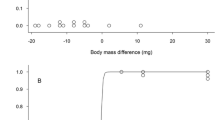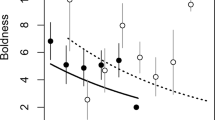Abstract
Butterflies are conspicuous among animals that fight for mating opportunities because it is not clear how contest costs could accrue. Nevertheless, the bulk of research in this group suggests that contests are settled on the basis of asymmetries in fighting ability (the superior competitor hypothesis). There is also a consistent effect on contest escalation due to apparent 'confusion' over residency, which could result from resident butterflies playing different tactics than non-residents, or from a causal link between residency and fighting ability. I addressed these hypotheses by studying contest behavior in the crepuscular species Melanitis leda (L.) (Nymphalidae) over a 5-month period in tropical Australia. Males competed via conspicuous two-stage maneuvers of a form unique among butterflies. Prior residents won 77% of all contests. Non-resident males arrived and perched in occupied sites until challenged by incumbent residents, and the aggressiveness of these interlopers increased as a function of the time before they were detected. Contest winners also tended to be younger than losers, and contest escalation was negatively related to both the age of the losing male and the magnitude of the between-combatant age asymmetry. These results are consistent with the superior competitor hypothesis based upon age as a determinant (or correlate) of fighting ability, but also suggest residency has a unique influence on contest behavior. Further research is clearly required to unravel the effects of age, residency and other potential biophysical determinants of fighting ability in this species.



Similar content being viewed by others
References
Alcock J, Bailey WJ (1997) Success in territorial defence by male tarantula hawk wasps Hemipepsis ustulata: the role of residency. Ecol Entomol 22:377–383
Baker RR (1972) Territorial behavior of the nymphalid butterflies, Aglais urticae (L.) and Inachis io (L.). J Anim Ecol 41:453–469
Cohen J (1988) Statistical power analysis for the behavioral sciences. Lawrence Erlbaum, Hillsdale, N.J.
Englund G, Olsson TI (1990) Fighting and assessment in the net-spinning caddis larva Arctopsyche ladogensis: a test of the sequential assessment game. Anim Behav 39:55–62
Enquist M, Leimar O (1983) Evolution of fighting behavior: decision rules and assessment of relative strength. J Theor Biol 102:387
Enquist M, Leimar O, Ljungberg T, Mallner Y, Segerdahl N (1990) A test of the sequential assessment game: fighting in the cichlid fish Nannacara anomala. Anim Behav 40:1–4
Field SA, Calbert G (1999) Don't count your eggs before they're parasitised: contest resolution and trade-offs during patch defense in a parasitoid wasp. Behav Ecol 10:122–127
Grafen A (1987) The logic of divisively asymmetric contests: respect for ownership and the desperado effect. Anim Behav 35:462–467
Gribbin SD, Thompson DJ (1991) The effects of size and residency on territorial disputes and short-term mating success in the damselfly Pyrrhosoma nymphula (Sulzer) (Zygoptera: Coenagrionidae). Anim Behav 41:689–695
Haley MP (1994) Resource-holding power asymmetries, the prior residence effect, and reproductive payoffs in male northern elephant seal fights. Behav Ecol Sociobiol 34:427–434
Hardy ICW (1998) Butterfly battles: on conventional contests and hot property. Trends Ecol Evol 13:385–386
Hardy ICW, Field SA (1998) Logistic analysis of animal conflicts. Anim Behav 56:787–792
Hernández MIM, Benson WW (1998) Small-male advantage in the territorial butterfly Heliconius sara (Nymphalidae): a paradoxical strategy? Anim Behav 56:533–540
Huntingford FA, Turner AK (1987) Animal conflict. Chapman and Hall, London
Johnsson JI (1996) Statistics and biological sense: a reply to Thomas and Juanes. Anim Behav 52:860
Kemp DJ (2000) Contest behavior in territorial male butterflies: does size matter? Behav Ecol 11:591–596
Kemp DJ (2002a) Visual mate searching behavior in the evening brown butterfly, Melanitis leda (L.) (Lepidoptera: Nymphalidae). Aust J Entomol 41:300–305
Kemp DJ (2002b) Butterfly contests and flight physiology: why do older males fight harder? Behav Ecol 13:456–461
Kemp DJ (2002c) Sexual selection constrained by life history in a butterfly. Proc R Soc Lond (B) 269:1341–1346
Kemp DJ, Wiklund C (2001) Fighting without weaponry: a review of male-male contest competition in butterflies. Behav Ecol Sociobiol 49:429–442
Krebs JR (1982) Territorial defense in the great tit (Parus major): do residents always win? Behav Ecol Sociobiol 11:185–194
Leimar O, Enquist M (1984) Effects of asymmetries in owner-intruder conflicts. J Theor Biol 111:475–491
Leimar O, Austad SN, Enquist M (1991) A test of the sequential assessment game: fighting in the bowl and doily spider Frontinella pyramitela. Evolution 45:862–874
Marden JH, Waage JK (1990) Escalated damselfly territorial contests are energetic wars of attrition. Anim Behav 39:954–959
Maynard Smith J (1982) Evolution and the theory of games. Cambridge University Press, Cambridge
Mesterton-Gibbons M, Adams ES (1998) Animal contests as evolutionary games. Am Sci 86:334–341
Parker GA (1974) Assessment strategy and the evolution of fighting behavior. J Theor Biol 47:223–243
Payne RJH (1998) Gradually escalating fights and displays: the cumulative assessment model. Anim Behav 56:651–662
Payne RJH, Pagel M (1996) Escalation and time costs in displays of endurance. J Theor Biol 183:185–193
Rosenberg RH, Enquist M (1991) Contest behavior in Weidemeyer's admiral butterfly Limenitis weidemeyerii (Nymphalidae): the effect of size and residency. Anim Behav 42:805–811
Rutowski RL (1992) Male mate-locating behavior in the common eggfly, Hypolimnas bolina (Nymphalidae). J Lepid Soc 46:24–38
Stutt AD, Willmer P (1998) Territorial defence in speckled wood butterflies: do the hottest males always win? Anim Behav 55:1341–1347
Tsubaki Y, Ono T (1987) Effects of age and body size on the male territorial system of the dragonfly, Nannophya pygmaea Rambur (Odonata: Libellulidae). Anim Behav 35:518–525
Waage JK (1988) Confusion over residency and the escalation of damselfly territorial disputes. Anim Behav 36:586–595
Wickman P-O, Wiklund C (1983) Territorial defence and its seasonal decline in the speckled wood butterfly (Pararge aegeria). Anim Behav 31:1206–1216
Acknowledgements
I thank John Alcock, Ron Rutowski and Christer Wiklund for helpful editorial comments and discussion. Three anonymous reviewers also provided informative critiques. This research was jointly supported by James Cook and Arizona State Universities.
Author information
Authors and Affiliations
Corresponding author
Additional information
Communicated by M. Elgar
Rights and permissions
About this article
Cite this article
Kemp, D.J. Twilight fighting in the evening brown butterfly, Melanitis leda (L.) (Nymphalidae): age and residency effects. Behav Ecol Sociobiol 54, 7–13 (2003). https://doi.org/10.1007/s00265-003-0602-7
Received:
Revised:
Accepted:
Published:
Issue Date:
DOI: https://doi.org/10.1007/s00265-003-0602-7




